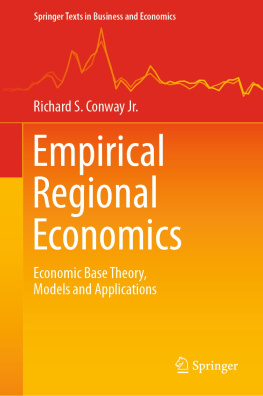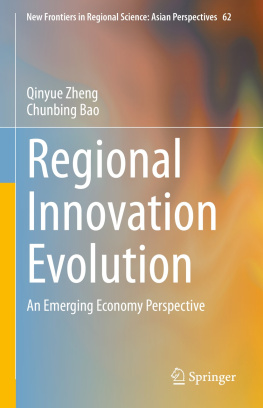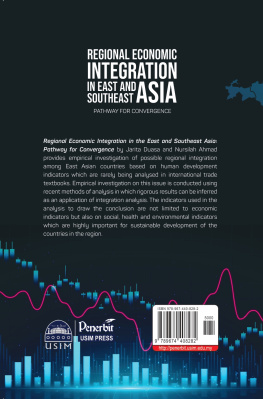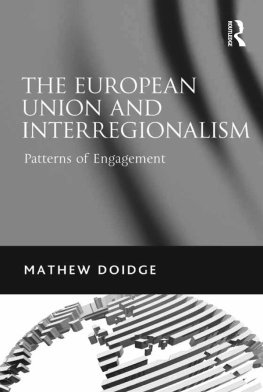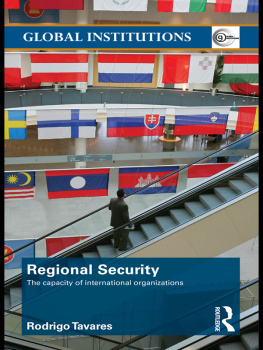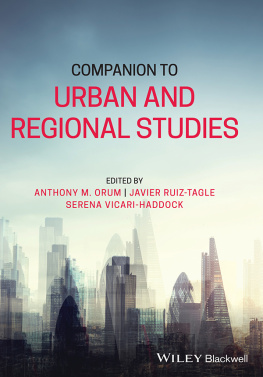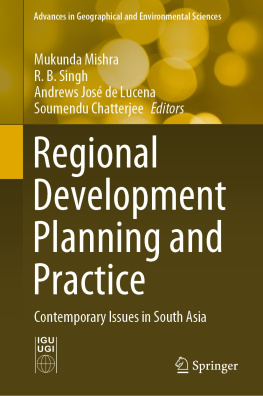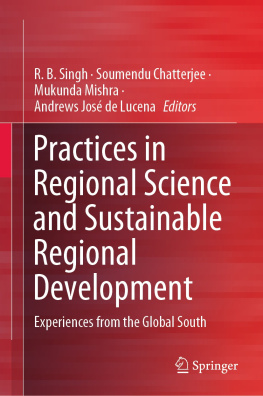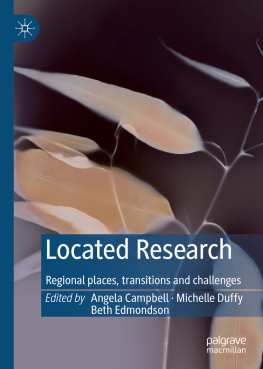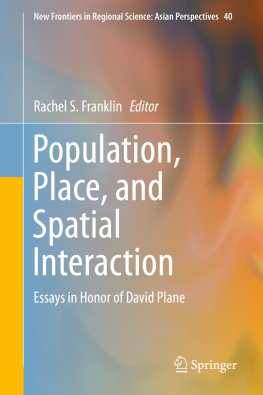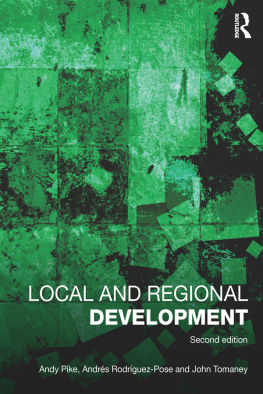Contents
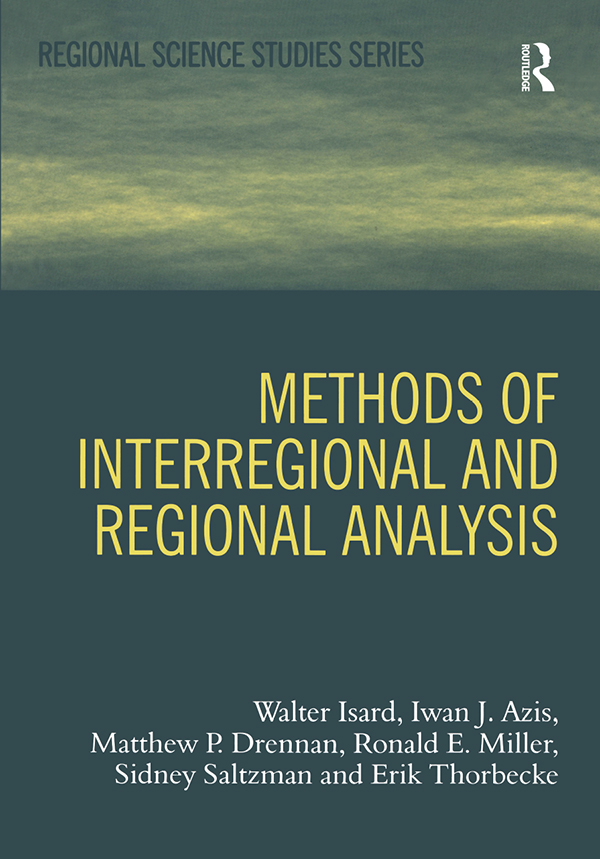
METHODS OF INTERREGIONALAND REGIONAL ANALYSIS
For Barclay G. Jones
and
Benjamin H. Stevens
Methods of Interregional and Regional Analysis
WALTER ISARD
IWAN J. AZIS
MATTHEW P. DRENNAN
RONALD E. MILLER
SIDNEY SALTZMAN
ERIK THORBECKE

First published 1998 by Ashgate Publishing
Published 2017 by Routledge
2 Park Square, Milton Park, Abingdon, Oxon 0X14 4RN
711 Third Avenue, New York, NY 10017, USA
Routledge is an imprint of the Taylor & Francis Group, an informa business
Copyright Walter Isard et al 1998
All rights reserved. No part of this book may be reprinted or reproduced or utilised in any form or by any electronic, mechanical, or other means, now known or hereafter invented, including photocopying and recording, or in any information storage or retrieval system, without permission in writing from the publishers.
Notice:
Product or corporate names may be trademarks or registered trademarks, and are used only for identification and explanation without intent to infringe.
British Library Cataloguing in Publication Data
Methods of interregional and regional analysis
1.Regionalism
I.Isard, Walter
304.2'3
Library of Congress Catalog Card Number: 98-071955
ISBN 13: 978-1-85972-410-1 (pbk)
Walter Isard, Professor Emeritus of Economics and Regional Science, Cornell University
Iwan J. Azis, Visiting Professor of Regional Science, Cornell University and Professor of Economics, University of Indonesia
Matthew P. Drennan, Professor of City and Regional Planning, Cornell University
Ronald E. Miller, Professor Emeritus of Regional Science, University of Pennsylvania
Sidney Saltzman, Professor of Regional Science and Planning, Cornell University
Erik Thorbecke, H. Edward Babcock Professor of Economics and Food Economics, Cornell University
In writing this book the authors wish to thank many scholars for recommendations on topics to be covered, suggestions for significant developments and writings in the field, and for critical but helpful comments. At the risk of failing to name all those to whom we are indebted, we note: Suarev Dev Bhatta, David E. Boyce, Steven B. Caldwell, A. Stewart Fotheringham, Eduardo Haddad, Geoffrey J. D. Hewings, Barclay G. Jones, Maureen Kilkenny, Jose Lobo, Joseph Mathews, Suahasil Nazara, Atsuyuki Okabe, David A. Plane, Adam Rose, Luis Santiago, Ashish Sen, Tony E. Smith, Benjamin H. Stevens, Michael Wegener and Masakazu Watanuki.
Extensive and careful typing was provided by Helena M. Wood and Gail A. Canterbury. In addition we were recipients of very fine technical typesetting by Henning Pape-Santos and excellent artwork by Helena M. Wood.
This book is dedicated to Barclay G. Jones and Benjamin H. Stevens. In their lifetimes, each has had an historic influence on the development of regional science. At Cornell University, Barclay G. Jones founded and nurtured over the years, graduate study in the field of regional science and organized its faculty. He effected a productive marriage of planning analysis and regional science and the many students he has had continue to pass on the fruits of this marriage throughout the world.
Benjamin H. Stevens contributed immensely to the development at the University of Pennsylvania of the regional science department in the early years when it confronted many difficulties. Of immeasurable value was his warmth and enthusiasm, and the stimulation and inspiration he provided graduate students and the faculty.
It has been 38 years since the 1960 book, Methods of Regional Analysis: An Introduction to Regional Science, was published. The writing of this book was motivated by the need to pull together at one place the diverse regional theories, hypotheses, concepts, techniques and tools existing in the social sciences, most of which were at an elementary/primitive level. Admittedly, at that time and earlier, except in sociology, regional analysis was close to the bottom rung in most areas of study. It was hoped that through discussions at the annual meetings of the newly formed Regional Science Association and the writing of a Methods book that the strengths of the diverse unconnected theories, concepts, techniques and tools could be joined. Thereby it was anticipated that a deeper understanding of regional phenomena could be achieved, and that there would evolve analytical methods of greater significance for coping with regional problems.
The book that resulted turned out to be successful in a number of respects, it being christened by some early graduate students as the bible of regional science. Its very success contributed to the great advance of regional science scholarship. As a result the 1960 book has become obsolete as a text for incoming graduate students in regional science and related areas such as planning analysis and quantitative geography.
Recognition of this obsolesce led faculty at Cornell in 1995 to address the problem of the lack of teaching materials for incoming graduate students. They reached the decision that a new up-to-date methods text should be written. In their desire to have input from interested regional scholars from around the world they organized Thursday night sessions at the annual North American Regional Science Association meetings. Those in attendance were informed of the progress in writing of the text and were encouraged to point out shortcomings and gaps in the coverage of relevant materials and to make suggestions for the further development of the text and changes in emphasis and topics. A number of fruitful recommendations were received which have been incorporated in the finished product.
This 1998 book contrasts with the 1960 one. The latter was able to cover most if not all of the advanced material current in regional science and related fields. This 1998 one cannot do so today since over the years regional science has advanced to the stage where it can be said to be comparable in quality and depth of analysis to the best of the social sciences. Consequently, it is now impossible to cover in a single text all the advanced materials in the field, let alone cover these materials in less than at least three years of intense graduate study. Hence, a text for the first year of such study can only provide a coverage that is comprehensive and yet of sufficient depth to pave the way for advanced research.
The orientation of the 1998 book also differs from that of 1960. While the 1960 book fully recognized the need for interregional analysis, it tended to concentrate on single region problems and effective attacks on them. This book places greater weight on interregional analysis (as is indicated in the title), and on greater understanding of the functioning of a system of regions, whether within a nation, or a global or continental community at one extreme or a small region comprising a set of urban communities at the other. Moreover, the relative importance assigned to the several methods has changed. Analysis of population (growth and decline) has been deemphasized and migration analysis has come to be explored by several methods of analysis econometrics, gravity and spatial interaction models, and microsimulation to name three thus finding a split home among them. In contrast, nonlinear programming models and general equilibrium analysis (in 1960 a purely conceptual framework) have come to the fore as a result of the computer revolution; and microsimulation, an intensive consumer of computer time, is seething at the bit. On the other hand, the comparative cost approach (for location problems of industry and service trades), input-output, and social accounting analysis (SAM) have held their own and gravity-type models have flourished, all having potential for further development as a result of the blossoming of GIS (geographic information systems), the comprehensive data base that replaces the meager data sets of the 1950s. Finally, the primitive statistical studies of the 1950s have been replaced by the rigorous approaches of Econometrics, the more advanced procedures of spatial econometrics still being beyond the scope of a first year graduate course.


